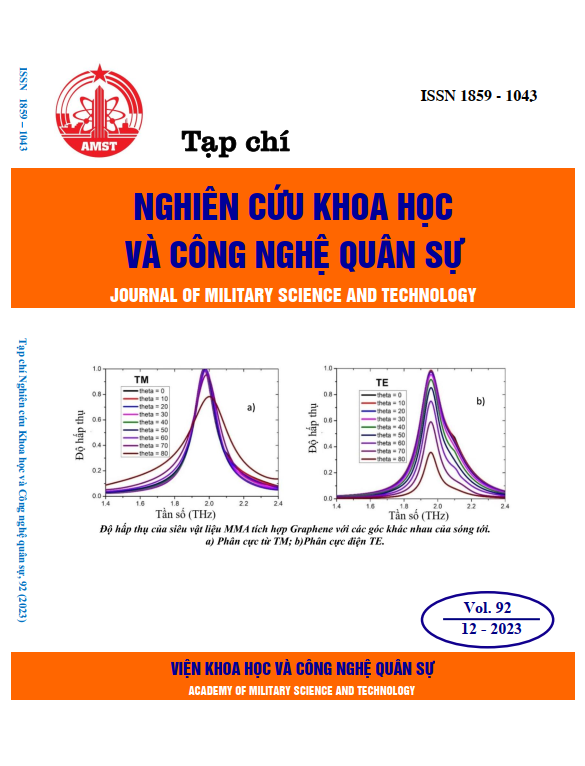Study on fabrication and evaluation of some properties of zero-valence Fe/Cu bimetallic nanomaterials by green synthesis method
597 viewsDOI:
https://doi.org/10.54939/1859-1043.j.mst.92.2023.46-54Keywords:
Fe/Cu; Bimetallic nanomaterials; Zero-valence; Green tea leaves.Abstract
This paper presents the results of research on the fabrication of zero-valence Fe/Cu bimetallic nanomaterials by polyphenol agent extracted from Vietnamese green tea leaves. The influence of a number of factors on the fabrication process has been studied, showing that the zero-valence Fe/Cu bimetallic nanomaterials have the best quality when dispersed in a 4/1(v/v) ethanol/H2O solvent mixture; polyphenol concentration in green tea extract 12.5 g/L; Fe/Cu ratio is 5/1, pH = 3 - 4, temperature 25 - 28 oC. Fe/Cu bimetallic nanomaterials have stable activity for 35 days, d = 0.921 g/cm3, particle size 37 - 45 nm and contain hydroxyl groups on the surface.
References
[1]. Tiziana Tosco et al., “Nanoscale zerovalent iron particles for groundwater remediation: a review”, Journal of Cleaner Production, 77, pp. 10-21, (2014). DOI: https://doi.org/10.1016/j.jclepro.2013.12.026
[2]. Denis O’Carroll, et al, “Nanoscale zero valent iron and bimetallic particles for contaminated site remediation”, Advances in Water Resources, 51, pp. 104-122, (2013). DOI: https://doi.org/10.1016/j.advwatres.2012.02.005
[3]. Nannan Qin et al., “Enhanced removal of trace Cr(VI) from neutral and alkaline aqueous solution by FeCo bimetallic nanoparticles”, Journal of Colloid and Interface Science, 472, pp. 8-15, (2016). DOI: https://doi.org/10.1016/j.jcis.2016.03.025
[4]. Shimin Zhou et al., “Enhanced Cr(VI) removal from aqueous solutions using Ni/Fe bimetallic nanoparticles: characterization, kinetics and mechanism”, RSC Advances, 4(92), pp. 50699-50707, (2014). DOI: https://doi.org/10.1039/C4RA08754B
[5]. Pengjun Li et al., “Enhanced nitrate removal by novel bimetallic Fe/Ni nanoparticles supported on biochar”, Journal of Cleaner Production, 151, pp. 21-33, (2017). DOI: https://doi.org/10.1016/j.jclepro.2017.03.042
[6]. Thabet Tolaymat et al., “Analysis of metallic and metal oxide nanomaterial environmental emissions”, J. Clean. Prod., 143, pp. 401-412, (2017). DOI: https://doi.org/10.1016/j.jclepro.2016.12.094
[7]. Kesarla Mohan Kumar et al., “Biobased green method to synthesise palladium and iron nanoparticles using Terminalia chebula aqueous extract”, Spectrochimica Acta Part A: Molecular and Biomolecular Spectroscopy, 102, pp. 128-133, (2013). DOI: https://doi.org/10.1016/j.saa.2012.10.015
[8]. V.R. Sinija, et al., “Process technology for production of soluble tea powder”, Journal of Food Engineering, 82(3), pp. 276-283, (2007). DOI: https://doi.org/10.1016/j.jfoodeng.2007.01.024
[9]. Trần Văn Nhân, “Giáo trình Hóa keo”, Nhà xuất bản Đại học Quốc gia Hà Nội, (2007).
[10]. Wei‐xian Zhang, “Nanoscale iron particles for environmental remediation: An overview”, Journal of Nanoparticle Research, 5, pp. 323-332, (2003). DOI: https://doi.org/10.1023/A:1025520116015
[11]. Foad Kazemi et al., “Photodegradation of methylene blue with a titanium dioxide/polyacrylamide photocatalyst under sunlight”, Journal of Applied Polymer Science, 133, p.43386, (2016). DOI: https://doi.org/10.1002/app.43386
[12]. Fatemeh Rezaei, et al., “Effect of pH on zero valent iron performance in heterogeneous Fenton and Fenton-like processes: A review”, Molecules, 23(12), pp. 3127-3145, (2018). DOI: https://doi.org/10.3390/molecules23123127
[13]. Hiroyuki Yoshino et al., “A phenomenological reaction kinetic model for Cu removal from aqueous solutions by zero-valent iron (ZVI)”, Chemosphere, 200, pp. 542-553, (2018). DOI: https://doi.org/10.1016/j.chemosphere.2018.02.127
[14]. T. Wang et al., “Green synthesized iron nanoparticles by green tea and eucalyptus leaves extracts used for removal of nitrate in aqueous solution”, Journal of Cleaner Production, 83, pp. 413-419, (2014). DOI: https://doi.org/10.1016/j.jclepro.2014.07.006
[15]. Ahmed M. Abdelfatah et al., “Green synthesis of nano-zero-valent iron using ricinus communis seeds extract: Characterization and application in the treatment of methylene blue-polluted ưater”, ACS Omega, 6(39), pp. 25397-25411, (2021). DOI: https://doi.org/10.1021/acsomega.1c03355







